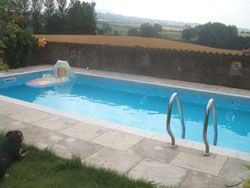This article follows on from my last on rain water harvesting, I have received a lot of questions on which is best above or below ground I hope to help answer this question. If the water is for garden and other outdoor use, above ground tanks are a cheaper and easier option than below ground tanks, mainly because installation is cheaper as there is no hole to be dug. But beware In hot weather, the rainwater will go off, but this should not be a concern for irrigation. No hole is needed but lifting equipment may be necessary.
Underground tanks have two great advantages over above ground models: the rainwater stays cool and fresh (no bacterial action takes place under 12 degrees) and the tank is both out of view and frees up space. There is a wide variety of tank available a professional Norwich Plumber should be able to advise which is best for your individual needs, most have filters that are self-cleaning and are installed in the turret of the tank rather than in the downpipe.
Using your Rainwater during Water Shortages
In April 2010 the new Flood and Water Management Bill came into force which gave water companies the legal right to impose stricter rules during water shortages. Before this Bill came into force, hosepipe bans covered irrigation and washing private cars, but now they have been extended to include amongst others, topping up pools, hot tubs, ornamental ponds and fountains whether with hosepipes or permanent plumbing.
A drought order prohibiting topping up can be imposed at any time. However, if you have installed a large capacity tank, there is a good chance of still being able to continue using these facilities just when they are most wanted.
A typical 10 x 5 metre pool which is kept covered will lose @ a rate of 30 litres a day through evaporation. In a 2 month drought that is a loss of @ 2000 litres. This figure could well be much more, bearing in mind continual use of a pool in a long dry spell. If rainwater is to be used to top up swimming pools then an underground tank should be used.
I hope this information helps you

